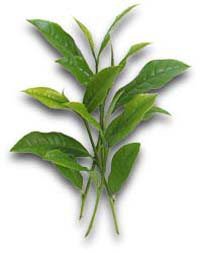
 The top two leaves and the bud—the unfurled leaf in the center—are the only three leaves picked from each branch of the tea plant. Photo courtesy DilmahTea.com. The top two leaves and the bud—the unfurled leaf in the center—are the only three leaves picked from each branch of the tea plant. Photo courtesy DilmahTea.com.
August 2005
Updated January 2010
|
 |
The History Of Tea
From Camellia To Clipper: Tracing Tea Through The Ages
You may have consumed thousands of cups of tea in your lifetime, without much thought of the genesis of this healthy brew. Here, a history of tea from ancient to modern times.
The origin of the wild tea plant, Camellia sinensis, has been traced to the area of Assam, India, and possibly also to China. Historically the origin of tea as a medicinal herb useful for staying awake—its initial use—is unclear. Cultivation of the tea plant can be traced back 2,000 years and more in Asia. Most historians would credit China as the birthplace of the beverage, tea, with hints of tea drinking in its history as far back as 1000 B.C.E. or earlier. The use of tea as a beverage drunk at social occasions dates back at least to the Tang Dynasty (618 to 907 C.E.), from when a treatise on the subject survives. Let’s take a brief look at the history of tea.
This is Page 1 of an eight-page article. Click the black links below to visit other pages.

Tea leaves. In India, the tea plant can
grow to 30 feet or more unpruned, but
is kept at 3 to 5 feet for convenient
plucking of the tender leaves.
The First Pot Of Tea Ever Brewed
The story of the origin of tea is, like many origins, lost to history. Possibly, ancient man, looking for sources of food, chewed on a leaf and noticed the energizing effects of the caffeine. However, colorful legends abound:
- According to Chinese legend, the story of tea began in 2737 B.C.E. when the legendary Emperor Shen Nong (variously spelled Sh’eng Nung), also a skilled scientist and the father of Chinese medicine, discovered it by accident. In the millennia prior to today’s safe, modern municipal water supplies, water bore many harmful microbes, and was boiled before drinking for safety. While boiling water in the garden (another variation has him out on a journey), a leaf from an overhanging wild tea tree drifted into his pot—inadvertently brewing the first pot of tea. The Emperor found the infused, unusually flavored water delicious, invigorating and refreshing. As a scientist, he further researched the plant and found that tea leaves eliminated numerous toxins from the body. Thus, tea is considered one of the earliest Chinese medicines.
- In an Indian variation, Gautama Buddha is said to have discovered tea when a falling tea leaf happened to land in his cup one day as he sat meditating in a garden.
- India, part of the indigenous tea-growing region, attributes the discovery of tea to Prince Bodhi-Dharma, an Indian saint who founded the Japanese Zen school of Buddhism. In 520 B.C.E., he left India to preach Buddhism in China, vowing to meditate for nine years. Toward the end of his meditation, he fell asleep. Upon awakening, he was so distraught that he cut off his eyelids. A tea plant sprung up from where his bloody eyelids hit the ground to sanctify his sacrifice. (Alternatively, he cut his eyelids off so that he wouldn't fall asleep while meditating, and the first tea plants sprang up from the ground where he flung the severed eyelids. Ouch!)
Continue To Page 2: The Evolution Of Tea
Culture In China & Japan
Return To Article Index At The Top Of The Page

|





